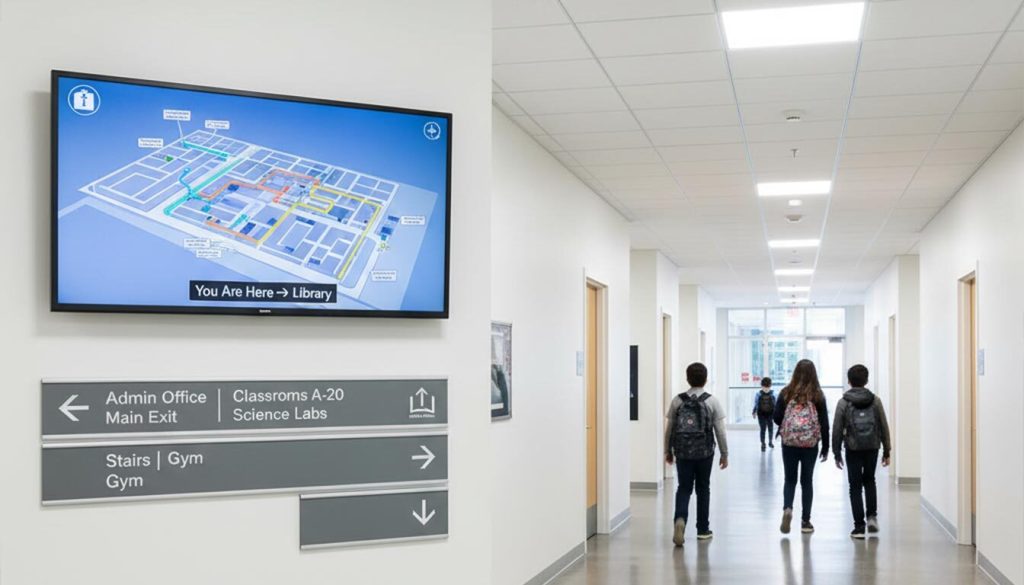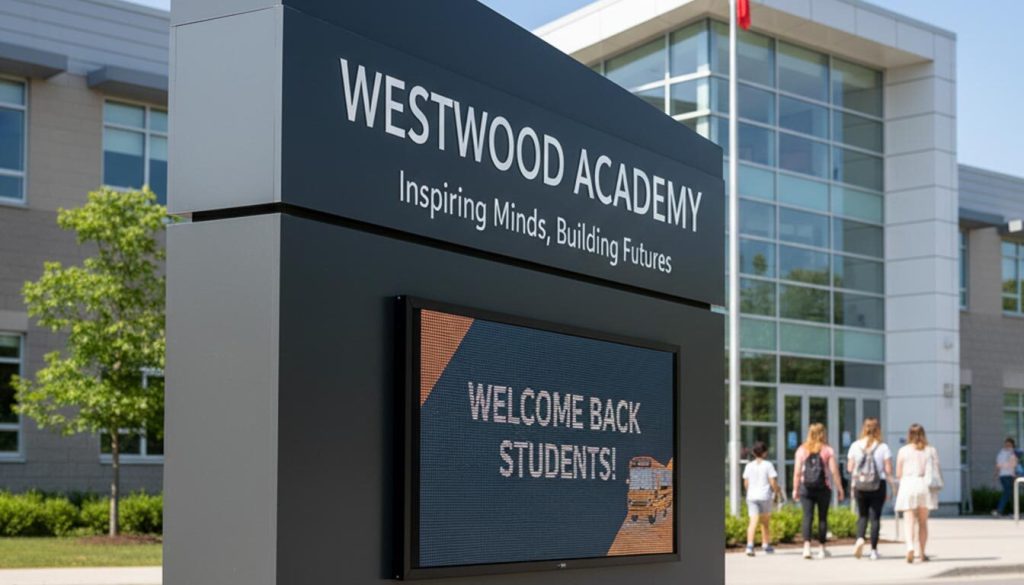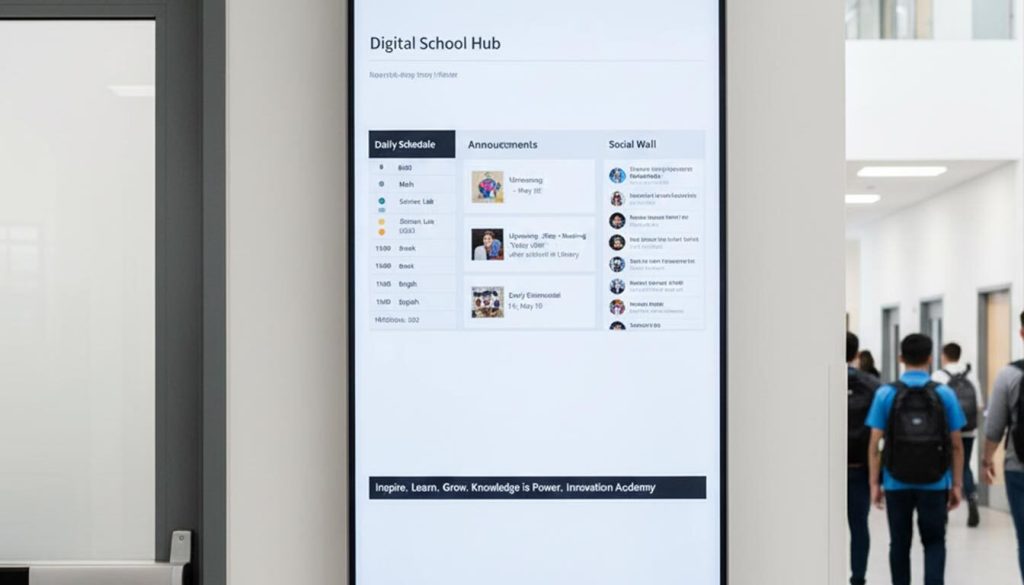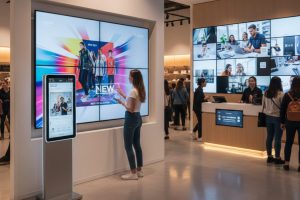In today’s technology-driven education environment, communication plays a crucial role in shaping student engagement, safety, and community identity. School signage has evolved far beyond static noticeboards — it now includes digital displays, interactive kiosks, and visual storytelling tools that inform and inspire.
This guide will walk you through 16 examples of digital school signage, showcasing how schools can integrate them into daily operations. You’ll also learn practical design and installation tips to create effective and visually cohesive signage that reflects your school’s values and enhances communication.
What Is School Signage and Why It Matters in Modern Education
School signage refers to the collection of visual and digital communication tools used throughout an educational facility to convey information, reinforce identity, and create a safe, engaging environment. Traditionally, this meant printed boards, banners, or static wayfinding signs. Today, however, digital technology has completely transformed how schools communicate.
Modern school signage includes LED displays, digital noticeboards, touchscreen directories, and even video walls that deliver live updates, event reminders, emergency alerts, and inspiring messages. They serve both functional and emotional purposes — from guiding visitors efficiently to fostering a strong sense of school spirit.
Why School Signage Matters
- Enhances Communication:
Effective school signage ensures important information reaches students, staff, and visitors quickly and clearly. Digital systems can display announcements, schedule changes, or safety instructions instantly. - Improves Engagement:
Interactive displays encourage student participation and creativity. They can showcase achievements, highlight projects, or even run digital competitions. - Promotes Safety and Compliance:
Digital signage can provide immediate safety alerts, fire evacuation instructions, and important updates during emergencies — improving the school’s response efficiency. - Strengthens Branding and Identity:
Consistent visual identity across signage helps reinforce the school’s values, colours, and logo. It projects professionalism and pride, making a lasting impression on visitors. - Supports Inclusivity:
Visual communication through clear graphics, simple language, and multilingual options ensures accessibility for all, including international students and parents.
The Shift from Traditional to Digital Signage
The move from static to digital school signage mirrors the evolution of learning environments themselves. With smart classrooms, online platforms, and connected devices, digital displays integrate seamlessly into the educational ecosystem.
Schools are no longer limited to printed posters or pinboards — they can now schedule automated messages, share live data (like attendance or weather), and display dynamic visuals that keep the campus alive and informed.
16 Examples of Digital School Signage You Can Implement
Schools today operate like miniature communities, with staff, students, and visitors interacting in multiple ways every day. To keep these environments safe, organised, and inspiring, well-planned school signage is essential.
Here are 16 examples of how digital signage can be used effectively across different areas of a school campus — from entrance halls to classrooms.
1. Welcome and Reception Screens
The reception area is often the first impression visitors get of a school. Digital school signage in this space can display:
- A warm welcome message
- The school’s name, motto, and crest
- Key staff members or visitor instructions
- Notices about open days or events
These screens set the tone for professionalism and friendliness while reducing the need for printed leaflets and wall clutter.
Pro Tip: Integrate a live time, date, and weather feed to make the welcome area feel modern and functional.
2. Digital Noticeboards
Gone are the days of overcrowded corkboards. Digital noticeboards display announcements, exam timetables, after-school club details, and attendance reminders.
They are easily updateable and can be programmed to change automatically, saving admin time.
Example Use: Display weekly newsletters or rotating slides that feature student work and upcoming events.
3. Classroom Display Screens
Inside classrooms, digital displays support both learning and information-sharing. Teachers can use them to:
- Share lesson objectives and daily schedules
- Display reminders or motivational quotes
- Showcase digital student projects
This type of school signage enhances interaction and keeps information visually accessible for all learners.
4. Canteen Menu Boards
Digital menu boards are not only visually appealing but also practical. They can:
- List daily meal options
- Display allergens and nutritional information
- Promote healthy eating campaigns
Dynamic menu boards make mealtimes more organised and improve the dining experience — especially in larger schools.
5. Hallway Communication Screens
Hallways are high-traffic zones, making them perfect for school signage that grabs attention during class transitions.
You can use them to:
- Announce achievements (sports, academics, or arts)
- Display school news and highlights
- Show live updates from school social media channels
Such content keeps the energy of the school positive and connected.
6. Event and Assembly Hall Displays
Large digital screens in assembly or performance halls can serve multiple functions:
- Announcing event schedules
- Streaming live performances or presentations
- Displaying visual backdrops for ceremonies
They help create immersive experiences and professional-quality events that elevate school culture.
7. Wayfinding and Directional Signage

Big campuses or multi-building schools benefit from digital wayfinding signage. These help students and visitors navigate efficiently by displaying:
- Interactive maps
- Classroom and department directions
- Accessibility routes for disabled visitors
Touchscreen kiosks or rotating floor maps make navigation seamless, particularly during open days or parent evenings.
8. Digital Trophy Boards and Achievement Displays
Celebrate success with digital displays that highlight student awards, staff recognition, or team victories.
These replace static photo frames with dynamic visuals, creating an evolving story of progress and pride that reflects the school’s community spirit.
9. Safety and Emergency Information Screens
In critical situations, such as fire drills or lockdowns, school signage can instantly communicate safety messages.
Screens linked to the school’s alert system can:
- Display evacuation routes
- Show assembly points
- Broadcast urgent instructions
This functionality enhances overall campus safety and ensures information reaches everyone simultaneously.
10. Library and Learning Resource Displays
Library digital screens can be used to promote reading campaigns, feature book recommendations, and highlight research resources.
They also serve as scheduling boards for library sessions, workshops, and student study zones — helping the library function as a central communication hub.
11. Digital Scoreboards and Sports Updates
For sports departments, digital scoreboards add excitement and professionalism to games.
You can use digital school signage to:
- Display live match scores
- Showcase team line-ups
- Announce upcoming fixtures
Schools with strong athletic programmes often integrate branding elements into these displays, boosting community support and pride.
12. Digital Timetables and Bell Schedules
Interactive timetable screens near corridors or classrooms can keep everyone updated with real-time changes in lessons, exams, or assemblies.
This is particularly useful for secondary schools or colleges with rotating schedules, ensuring students stay informed even if plans change last-minute.
13. Eco and Sustainability Boards
To promote environmental awareness, schools can use digital screens for campaigns about recycling, energy saving, or sustainability initiatives.
Unlike printed posters, they align with eco-conscious values by reducing paper waste while keeping messages dynamic and updated.
14. Alumni and Community Display Boards
Schools can foster long-term engagement by showcasing alumni achievements or upcoming community events on digital displays.
This reinforces the sense of belonging and encourages networking between former students and current learners.
15. Staff Communication Boards
Internal school signage can serve teachers and staff by sharing notices about:
- Staff meetings
- Training sessions
- Duty rosters or policy updates
These displays can be positioned in staff rooms or administrative areas, ensuring timely communication within the team.
16. Outdoor LED Signage
Finally, outdoor digital signs are powerful tools for visibility and branding. Positioned near entrances or car parks, they can:
- Announce school events
- Display welcome messages
- Share emergency notifications
Outdoor displays enhance the school’s image and attract positive attention from parents and the local community.
Benefits of Digital School Signage for Different Stakeholders

Digital signage in schools does far more than simply replace old noticeboards. It transforms how information flows across the campus — improving efficiency, communication, safety, and community spirit. Each stakeholder experiences unique advantages, all contributing to a more connected and engaging learning environment.
1. Benefits for Students
Engagement and Awareness
Digital school signage helps students stay informed about day-to-day events, extracurricular activities, and academic deadlines. Visual displays are naturally attention-grabbing, making students more likely to absorb messages about attendance, safety, or upcoming assemblies.
Motivation and Recognition
Displaying achievements — such as exam results, awards, or student artwork — motivates learners and fosters a positive school culture. Recognition on a digital screen gives students a sense of pride and encourages others to strive for success.
Navigation and Safety
Interactive signage or digital maps can help students navigate large campuses, find classrooms, or locate departments. During emergencies, screens can instantly display evacuation routes or alerts, ensuring safety protocols are followed swiftly.
Inclusivity and Accessibility
Dynamic signage can include multilingual support or visual cues for students with different learning needs, making communication more inclusive and equitable across the student body.
2. Benefits for Teachers and Staff
Streamlined Communication
Teachers no longer rely on printed memos or word-of-mouth updates. Digital screens ensure consistent, real-time communication across the campus — whether it’s a staff meeting reminder or a timetable update.
Enhanced Teaching Support
Classroom-based digital signage can serve as a teaching aid, allowing teachers to display subject content, videos, or student work with ease. It encourages interactive learning and makes lessons more dynamic.
Time Efficiency
Digital signage reduces administrative burdens. Instead of manually updating posters or distributing notices, staff can upload content in seconds using a central management system.
Professional Environment
Modern displays convey an image of technological sophistication and organisation — reinforcing staff pride and improving internal morale.
3. Benefits for Parents
Improved Transparency
Parents can be kept informed about school events, open days, or parent-teacher meetings through external screens or digital displays near reception areas. When integrated with social media or websites, this content can also reach them remotely.
Trust and Engagement
When parents see transparent, consistent updates across school premises, it builds trust and strengthens their relationship with the institution.
Instant Notifications
In emergencies or weather-related closures, digital signage allows immediate visual alerts — ensuring parents and visitors are promptly informed upon arrival.
4. Benefits for Visitors and the Wider Community
First Impressions
Your school signage acts as a visual ambassador. A digital welcome screen in the reception area immediately sets a professional and welcoming tone for new visitors, Ofsted inspectors, or local authorities.
Navigation and Safety
Interactive wayfinding displays can help visitors locate specific classrooms, departments, or offices without needing constant assistance from staff.
Community Engagement
Schools often serve as community hubs. Digital signage can promote local partnerships, upcoming charity events, and achievements — strengthening bonds with local businesses and residents.
5. Benefits for School Management
Centralised Control
Administrators can manage all screens from a single dashboard, ensuring consistency across multiple buildings or campuses. Scheduled content updates and templates simplify daily communication.
Data-Driven Decisions
Modern digital signage systems allow schools to monitor engagement metrics — such as how long certain slides are displayed or which content receives the most attention. This helps refine messaging strategies.
Long-Term Cost Savings
Although there’s an initial investment, schools save substantially on printing costs, paper waste, and staff time in the long term.
Enhanced Reputation
Schools that implement professional signage demonstrate commitment to innovation, safety, and communication — enhancing reputation and appeal to prospective families.
Bringing Your School Vision to Life with Digital Signage
In today’s fast-evolving educational environment, communication must be clear, inclusive, and adaptable — and school signage stands at the heart of this transformation. From interactive maps to motivational digital walls, it enhances not only the way information is shared but also how students, staff, and visitors experience your institution.
Digital signage helps create a sense of belonging, modernises campus communication, and strengthens the overall brand identity of your school. Whether used for safety, engagement, or community-building, the technology offers a versatile platform that grows with your needs.
The key to success lies in aligning your school signage with your school’s ethos. Every message displayed — from welcome screens to celebration walls — should reflect your values, energy, and commitment to innovation.
How Msigns Can Help You Design Effective School Signage
At Msigns, we understand that school signage is more than just visuals — it’s about creating an environment that communicates with clarity, inspires learning, and reinforces identity.
We provide end-to-end signage solutions that combine functionality and aesthetics, including:
- Custom digital display systems tailored to your school’s layout and goals.
- Interactive design options for wayfinding, event promotion, and safety communication.
- Consistent branding support to ensure your school’s message and visuals stay cohesive.
- Ongoing maintenance and technical support, ensuring your signage remains reliable and up-to-date.
Our experts work closely with you to assess your environment, recommend signage types that fit your needs, and design content strategies that captivate your audience. Whether you’re upgrading existing systems or implementing new digital communication tools, Msigns ensures your school’s story is told in the most engaging, professional way possible.
Ready to Transform Your School Environment?
Let’s bring your vision to life.
Contact Msigns today to discuss your digital school signage needs — and discover how modern signage can turn your campus into a smarter, more connected, and inspiring space.

















